In humid seasons or in poorly ventilated environments, moldy furniture is a problem that plagues many families. Mold not only affects the appearance, but may also release spores to cause allergies, respiratory diseases, and even damage the structure of furniture. How to clean moldy furniture scientifically and safely? This article combines expert advice and experimental data to provide you with practical solutions.

Ⅰ. The "culprit" of mold growth
Mold is a type of fungus, and its spores are widely present in the air. When the ambient humidity exceeds 60%, the temperature is 20-30℃ and there is a lack of ventilation, spores will multiply rapidly on the surface of organic materials such as wood and fabrics. The U.S. Environmental Protection Agency (EPA) pointed out that long-term exposure to mold environments may aggravate asthma symptoms and cause infection in people with low immunity.
Ⅱ. Safety preparation before cleaning
1. Personal protection: Wear N95 masks, rubber gloves and goggles to avoid direct contact with mold.
2. Isolate contaminated areas: Close the door of the room and cover the non-moldy area with plastic sheeting to prevent the spread of spores.
3. Ventilation: Open doors and windows or use fans to exhaust air to reduce the concentration of spores in the air.
Ⅲ. Cleaning guide by material
1. Wooden furniture
① Mild mold: Use a soft brush to remove surface mold, then wipe with a cotton cloth dipped in 70% alcohol or white vinegar (1:1 water), and finally dry the moisture with a dry cloth.
② Deep penetration: If the mold stain penetrates the wood, apply hydrogen peroxide (hydrogen peroxide) and let it stand for 10 minutes, then gently polish the surface with sandpaper (120 mesh), and finally apply wood wax oil for protection.
③ Note: Avoid using bleach, which may corrode wood fibers and release harmful gases.
2. Fabric furniture
① Removable and washable fabrics: Soak sofa covers in 60℃ hot water, add oxygen bleach (such as sodium percarbonate) and soak for 30 minutes, machine wash and dry in the sun.
② Non-removable parts: Cover the mold with baking soda, let it sit for 2 hours, then use a vacuum cleaner to remove it, and then spray it with tea tree essential oil (10 drops in 200ml of water) to sterilize.
3. Leather furniture
After wiping with a special leather cleaner, apply a 1:1 mixture of olive oil and white vinegar to nourish the leather while inhibiting mold regeneration. Severe mold needs to be sent to a professional agency for treatment.
IV. When should moldy furniture be discarded?
If the following situations occur, it is recommended to replace the furniture to ensure health:
1. The mold coverage area exceeds 1/3 of the furniture surface;
2. The wood inside is rotten and the structure is loose;
3. There is still a pungent moldy smell after cleaning, or the user has a persistent allergic reaction.
V. Scientific mold prevention: blocking from the source
1. Humidity control: Keep the indoor humidity below 50%, and use a dehumidifier or air conditioner dehumidification mode during the rainy season.
2. Enhance ventilation: Open windows for at least 30 minutes every day, and keep a gap of more than 5cm between furniture and wall.
3. Regular inspection: Place bamboo charcoal bags or diatomaceous earth in the corners of the cabinet to absorb moisture and replace them every month.
4. Emergency treatment: Wipe water stains immediately and use ultraviolet mite removal lamp (wavelength 270-300nm) for sterilization.
